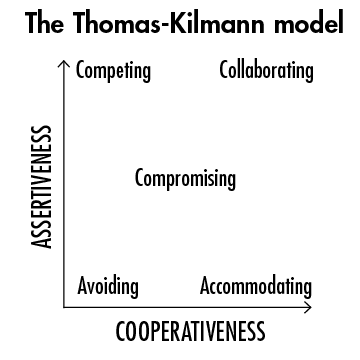The Thomas-Kilmann Model: A helpful tool for examining how you respond to conflict
Interpersonal conflict is something that happens often at work. We don’t like to talk about it, it’s not always the most fun to deal with – but it’s a fact of life. Conflict in general is a fact of life!
In fact, conflict is often the basis for transformational change – for businesses, for teams, and for individuals. So why does it get such a bad rap? For many of us, I think discomfort stems from two places:
1. Societally, we learn as kids that “everyone should get along” and then when conflict naturally arises, we think that there’s something “wrong” with us that we’re not getting along with the other person.
2. We’re never taught tools for recognizing and managing conflict, let alone how to productively disagree, or work our way through that conflict.
This is why it’s essential that we offer these tools to our employees, to help them better manage interpersonal conflict in the workplace (and to ideally get managers out of the middle.) Zingerman’s has long taught a class – originally called ‘Caring Confrontations’, it’s a two-hour class that was re-named ‘Courageous Conversations’ several years ago. When a client requested that class for their organization, we did some research to find information and tools that would add context to the solid content we’ve been teaching internally for years.
One of the tools we came across that really enriched our understanding of conflict, and became a mainstay of our newly popular Courageous Conversations Virtual Workshop, is known as The Thomas-Kilmann Model. Named after its two psychologist originators, Dr. Kenneth Thomas and Dr. Ralph Kilmann, the Thomas-Kilmann model lays out 5 different modes of how people handle conflict, on axes of assertiveness and cooperativeness.

What’s particularly helpful about this model is that it names ways that we react to conflict, knowingly or unknowingly. Since we began teaching this model to clients, every single one of them has been able to identify situations in their own life where they defaulted to one mode or another – and almost always can identify their default mode of responding to conflict. No single mode is “right” or “wrong” – each mode has advantages and disadvantages.
Here are the five modes of responding to conflict, according to this Model:
Avoiding
What this looks like: One person disengages, walks away, or shuts down. The other person may have no idea there was ever an issue!
Disadvantages [-] : Sidestepping the issue or not making any attempt to resolve an issue. Can bottle up until you explode!
Advantages [+] : When the potential risk outweighs the potential benefit of the resolution, for example, if you have a fear of retaliation. Or when the issue is trivial to you.
Accommodating
What this looks like: Sometimes, this can look the same as avoiding. I think the major difference here comes more in the form of an active choice to accommodate.
[-]: Often done at the expense of yourself – putting others’ needs above your own.
[+]: This can come as an act of generosity. If you know something is going on in the other person’s life that is causing them to lash out, you may choose to be accommodating (up to a point.)
Competing
What this looks like: Often, having to win. Talking over someone else, speaking in absolutes.
[-]: It’s putting your needs above the needs of everyone else. “Winning” means the other person loses.
[+]: When you’re standing up for yourself, or you’re defending what you believe to be right. Standing firm.
Compromising
What this looks like: 50-50 solution, splitting the difference, meeting in the middle.
[-]: When a solution is 50-50, no one is completely satisfied
[+]: This can lead to a faster resolution in the moment, which could be followed up with an additional conversation.
Collaboration
What this looks like: 100-100 solution, where both parties are actively working together to learn more about the other, to get to the root of the conflict, and to positively resolve the issue.
[-]: It can take more time to get to 100-100 – and both people need to be willing.
[+]: This is the gold standard! When working together to resolve conflict, it can become an expansive conversation with room for creativity and growth for both people – and often leads to stronger working relationships.
As I mentioned before, no one mode is “correct” – different modes are completely appropriate for different situations, different relationships, and different conflicts.
So, what to do with this information? Next time you’re finding yourself in a situation where you recognize that you’re avoiding, accommodating, competing, compromising or collaborating, take a moment to pause and think about whether that’s the mode that you want to use. If you find yourself defaulting to a mode that isn’t serving you well, actively choose another mode.
Here are a couple of examples:
1. In a regular meeting, you’ve got a co-worker who is extremely extroverted and outgoing, and VERY free with their opinion, often to the detriment of others on your team. You’ve avoided the conflict thus far – but so has everyone, and nothing is changing. Before the next meeting, you’re going to stand up for yourself, and the quieter folks on your team, by talking to the co-worker in advance and asking him to give a little space for the others.
2. You’ve accommodated a colleague for several months, knowing that they’re going through a difficult situation at home. But you’ve realized that this colleague is starting to treat you like a doormat, not as a kind, accommodating human. The next time something comes up, you might choose to approach the situation with compromise in mind – or even competing, to make it clear you’re not a doormat!
If you’d like to learn more about how to handle interpersonal conflict and have Courageous Conversations, please join us for a workshop soon!
 Back to Library
Back to Library




